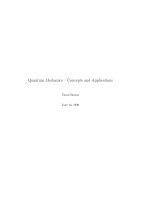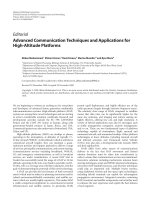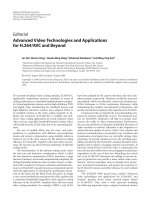Organic chemistry concepts and applications for medicinal chemistry
Bạn đang xem bản rút gọn của tài liệu. Xem và tải ngay bản đầy đủ của tài liệu tại đây (2.08 MB, 210 trang )
Organic Chemistry
Concepts and
Applications for
Medicinal Chemistry
JOSEPH E. RICE
Associate Professor of Medicinal Chemistry
Department of Medicinal Chemistry
Ernest Mario School of Pharmacy
Rutgers, The State University of New Jersey
Piscataway, NJ 08854-8020
AMSTERDAM • BOSTON • HEIDELBERG • LONDON
NEW YORK • OXFORD • PARIS • SAN DIEGO
SAN FRANCISCO • SINGAPORE • SYDNEY • TOKYO
Academic Press is an imprint of Elsevier
www.pdfgrip.com
Academic Press is an imprint of Elsevier
525 B Street, Suite 1900, San Diego, CA 92101-4495, USA
225 Wyman Street, Waltham, MA 02451, USA
© 2014 Elsevier Inc. All rights reserved.
No part of this publication may be reproduced, stored in a retrieval system or transmitted
in any form or by any means electronic, mechanical, photocopying, recording or otherwise
without the prior written permission of the publisher.
Permissions may be sought directly from Elsevier’s Science & Technology Rights
Department in Oxford, UK: phone (+44) (0) 1865 843830; fax (+44) (0) 1865 853333;
email: Alternatively you can submit your request online by
visiting the Elsevier web site at and selecting
Obtaining permission to use Elsevier material.
Notice
No responsibility is assumed by the publisher for any injury and/or damage to persons or
property as a matter of products liability, negligence or otherwise, or from any use or
operation of any methods, products, instructions or ideas contained in the material herein.
Because of rapid advances in the medical sciences, in particular, independent verification of
diagnoses and drug dosages should be made.
Library of Congress Cataloging-in-Publication Data
Rice, Joseph E., author.
Organic chemistry concepts and applications for medicinal chemistry / Joseph E. Rice,
Rutgers, the State University of New Jersey.
pages cm
Includes bibliographical references (pages).
ISBN 978-0-12-800739-6
1. Clinical chemistry. 2. Biochemistry. 3. Organic compounds. I. Title.
QD415.R48 2014
547--dc23
2014005300
British Library Cataloguing in Publication Data
A catalogue record for this book is available from the British Library
ISBN: 978-0-12-800739-6
For information on all Academic Press publications
visit our web site at store.elsevier.com
Printed and bound in USA
14 15 16 17 18 10 9 8 7 6 5 4 3 2 1
www.pdfgrip.com
DEDICATION
This book is dedicated to my wife Dorothy and my daughters Jennifer
and Christina.
www.pdfgrip.com
PREFACE
Medicinal chemistry is a discipline that is focused on the relationship
between chemical structure and biological activity. This relationship serves
as the basis for the design and synthesis of new drug entities. Knowledge of
medicinal chemistry is therefore of utmost importance to students in pharmacy programs, to medical and nursing students, and to chemists involved
in the drug design process.
Pharmacy students at Rutgers take organic chemistry as sophomores but
are not taught medicinal chemistry until their fourth year. Shortly after I
started teaching medicinal chemistry I noticed that many students had difficulty recalling some of the important concepts from two years prior. To
address that need I wrote an extended handout to serve as a review. Over
the years that handout has been revised and amended numerous times. This
book grew out of those efforts.
The first four chapters provide a review of important concepts first
introduced in organic chemistry. Among the topics covered are chemical
bonding, stereochemistry and conformation, functional groups and acid–
base chemistry. It is essential that the students thoroughly understand these
principles so as to be able to fully grasp the subtle relationship between
chemical structure and pharmaceutical activity that is at the core of medicinal chemistry. Reaction mechanisms and chemical transformations, while
certainly of great importance to those involved in the synthesis of new drug
entities, are not discussed in this book.
Chapter five introduces the student to partition coefficients, a subject
not likely covered in undergraduate organic chemistry courses. The ease
with which a drug passes from one compartment of the body to another is
related to its partition coefficient. Like every other property, partition coefficients depend on structure with each portion of a molecule contributing
to its overall hydrophobicity or hydrophilicity.
An integral part of medicinal chemistry education at Rutgers is training
students to draw the correct structure of a drug when presented with its
systematic name.The sixth chapter of this book is therefore concerned with
nomenclature. While the naming of simple compounds such as alkanes,
alkenes, alkynes, alcohols, amines, and carbonyl derivatives is introduced in
almost all organic chemistry courses, the systematic nomenclature of heterocyclic compounds and complex polycyclic ring systems is generally not
ix
www.pdfgrip.com
x
Preface
covered. Chapter six begins with a discussion of relatively simple heterocyclic ring systems and then progresses to more complex compounds that
involve fused, bridged, and spiro polycyclic compounds. Such ring systems
form the basis of a majority of drug structures. A series of rules for numbering these ring systems is described. Methods are also described for specifying the attachment of highly complex substituents onto parent compounds.
The last section of this chapter focuses on the special nomenclature and
numbering of a few natural product classes of medicinal interest including
steroids, prostaglandins, and morphinans.
The chemistry of drug metabolism is reviewed in the final chapter of
this book. Most foreign chemicals become transformed once they enter the
body. In this process, which is known as metabolism, some existing functional groups on compounds undergo chemical changes while in other
instances new functionality is added. Most commonly this is done to aid in
the removal of the foreign substance from the body.The reader will learn to
associate a variety of structural features of drug molecules with likely metabolic pathways and will become familiar with the chemical processes that
are involved in the formation of specific metabolites.
Joseph E. Rice
Ernest Mario School of Pharmacy
Rutgers, The State University of New Jersey
www.pdfgrip.com
1
CHAPTER
Bonding in Organic Compounds
By the time most students in the pharmaceutical sciences get to their third or
fourth year, they have very likely already taken general chemistry and organic
chemistry and have been exposed to the concepts of chemical bonding several
times. The reader is likely asking: Why waste time going over this again when
there are more interesting topics to explore? After all, it’s pretty simple. Electrons
are shared between two atoms to form bonds. There are single bonds, double
bonds, and triple bonds. Can we now move on and get to something new?
The truth is that one cannot begin to understand organic chemistry unless
he/she has a thorough understanding of the bonds that hold organic compounds together. It is the bonds that determine the three-dimensional shapes of
molecules. With many drug molecules, shape is a factor that determines how
the drug molecule interacts with its receptor. The bonds in a molecule also
determine its chemical reactivity and properties. Again with drug molecules,
reactivity relates to its chemical stability and to the types of metabolic transformations the drug may undergo. Bonds affect the acid/base properties of a compound and also affect the solubility. For drugs, the relative solubility in water and
lipids affects how the molecule passes from one bodily compartment to another.
ATOMIC ORBITALS
Most drugs are organic compounds and have structures that are largely composed of carbon atoms. Carbon (atomic number 6) has a nucleus containing six
positively charged protons. As a counterbalance, six negatively charged electrons orbit the nucleus. Electrons are restricted to orbitals, which are the functions that represent the probability of finding a given electron in space. Any
orbital can be occupied by a maximum of two electrons, and these must have
opposite spin quantum numbers (represented as ↑ or ↓). The shapes of orbitals
are designated with small letters such as s, p, d, or f. Elements that are in the first
row of the Periodic Table (hydrogen and helium) have only a single shell of
electrons that reside in an s-orbital. In the second row, two shells exist. The
second shell being larger than the first can contain more electrons, which are
held in one s-orbital and three p-orbitals.Third row elements have three shells
of electrons with the third now capable of having five d-orbitals in addition to
Organic Chemistry Concepts and Applications for Medicinal Chemistry
© 2014 Elsevier Inc.
All rights reserved.
1
www.pdfgrip.com
2
Joseph Rice
Table 1.1 The First Three Rows of the Periodic Table
I
II
1
2
3
III
H
Li Be
Na Mg
B
Al
IV
V
VI
VII VIII
C
Si
He
N O F Ne
P S Cl Ar
the one s- and three p-orbitals.Thus the row number in the Periodic Table tells
how many shells of electrons a particular element contains (Table 1.1).
Electrons in s-orbitals are distributed spherically symmetrical about the
nucleus (like a hollow ball with the nucleus at the center). Carbon, being
found in the second row of the Periodic Table, has two shells of electrons.Two
electrons are contained within the 1s orbital and the remaining four are found
in the orbitals of the second shell. Note the fact that carbon is located in
Group IV of the Periodic Table and has four electrons in the outer shell or
valence shell. Electrons completely populate lower energy orbitals before higher
energy orbitals.This is known as the Aufbau principle.Thus the 1s orbital, being
closer to the nucleus, is filled before the 2s orbital. Within a given shell, the
s-orbital is lower in energy than the p-orbitals.The three p-orbitals are dumbbell shaped and are mutually perpendicular to one another, directed along the
x-, y-, and z-axes (px, py, and pz). They are also equivalent in energy (degenerate). The remaining valence electrons first fill the 2s orbital and then partially
fill two of the degenerate p-orbitals. Hund’s Rule states that electrons must be
placed singly into degenerate orbitals before they can be paired. Thus the
electronic configuration for carbon becomes 1s22s22px12py1. In general, only
electrons in the valence shell participate in chemical bonding (Figure 1.1).
z
y
z
x
2s
y
z
x
2px
y
z
x
2py
y
x
2pz
Figure 1.1 Valence shell orbitals of second row elements.
Elements in the second row of the Periodic Table have four orbitals in
the valence shell and these can hold up to a total of eight electrons (Table
1.2). Neon, with each of its orbitals completely filled, cannot accept any
more electrons and is reluctant to give any away. It is therefore chemically
inert, as are other members of Group VIII. As you move from left to right
www.pdfgrip.com
Bonding in Organic Compounds
3
Table 1.2 Electronic Configurations for the Second-Row Elements
Li
Be
B
C
N
O
F
Ne
2s1
2s2
2s22px1
2s22px12py1
2s22px12py12pz1
2s22px22py12pz1
2s22px22py22pz1
2s22px22py22pz2
Group I
Group II
Group III
Group IV
Group V
Group VI
Group VII
Group VIII
across the Periodic Table within a particular row, each nucleus has one more
proton than its neighbor at the left. The nuclear charge increases accordingly, but the distance from the nucleus to the valence electrons remains
about the same. Thus the attraction of the nucleus for the valence electrons
increases from left to right. This is known as electronegativity. Electronegativity also increases as you move up the Periodic Table within any given group
(column) [as you move up in any group, the valence shell electrons are getting closer to the nucleus and are thus pulled at by the nucleus to a greater
extent]. Fluorine is the most electronegative element (4 on a scale of 0–4).
Now that we know something about carbon it is time to start combining
it with other elements to form molecules. The simplest organic compound
is methane, CH4, so let us see how it is constructed. Organic compounds are
held together primarily by covalent bonds. Such bonds are formed whenever
two valence electrons are shared between adjacent atoms. Since the 2px
orbital of carbon has a single electron, it can overlap with a hydrogen 1s
orbital, which also has one electron, and they can form a C–H bond. A similar scenario can be achieved with the 2py orbital of carbon and another
hydrogen atom. However, a problem now arises when trying to bond the
remaining two hydrogens with carbon. The 2pz orbital is vacant, and overlapping with a 1s orbital of hydrogen would not result in a bond being
formed because a covalent bond requires two electrons to be shared. Likewise, the carbon 2s orbital is completely filled, and overlapping with a hydrogen 1s orbital would result in two atoms sharing three electrons, which is also
impossible. Thus if we use only the atomic orbitals of carbon to bond with
hydrogen, we can form only CH2 and predict that it would have a H-C-H
bond angle of 90°. As anybody who has ever driven past a landfill can attest
to, however, methane is a very real compound. Moreover, it has been established that CH4 is tetrahedral in shape. The question is, therefore, how can
we account for both the composition of methane and its shape (Figure 1.2)?
www.pdfgrip.com
4
Joseph Rice
H1s
2px
2py
H
C2py
2pz
C2s
H1s
C
H
C2px
Energy
2s
Carbon valence orbitals
1s
1s
1s
1s
H-1
H-2
H-3
H-4
Hydrogen valence orbitals
Figure 1.2 The atomic orbitals involved in forming methane. Inset box shows a pictorial
representation of the results of using the carbon atomic orbitals to bond with hydrogen.
HYBRID ORBITALS
Orbitals, as mentioned previously, are probability functions. Linus Pauling recognized that as functions they can be manipulated mathematically by taking
linear combinations [1]. When combining four functions, one obtains four
new functions. In the case of the valence orbitals of carbon, those four
functions are the 2s, 2px, 2py, and 2pz orbitals.These are combined as follows:
3
2s + 2px + 2py + 2pz = sp hybrid orbital
3
2s + 2px + 2py − 2pz = sp hybrid orbital
3
2s + 2px − 2py + 2pz = sp hybrid orbital
3
2s − 2px + 2py + 2pz = sp hybrid orbital
Each of the resulting hybrid orbitals have 25% s-character and 75%
p-character and so look like distorted dumbbells, with one lobe substantially larger than the other. In addition, the four new sp3 hybrid orbitals are
directed to the corners of a tetrahedron (Figure 1.3).
The newly formed sp3 hybrid orbitals are degenerate and hence each is
populated by a single electron from the carbon’s four valence electrons
(Figure 1.4). Since there are now four singly populated orbitals, it becomes
easy to see how they can each overlap with a hydrogen 1s orbital to form
four C–H bonds. Also, since those orbitals point to the corners of a tetrahedron, the three-dimensional shape of methane must also be tetrahedral. The
www.pdfgrip.com
Bonding in Organic Compounds
+
+
+
-
+
+
+
-
+
+
+
-
5
Figure 1.3 Pictorial representation of taking a linear combination of the four carbon
valence orbitals to form sp3-hybrid orbitals.
2px
2py
Hybridization
2pz
sp3
sp3
sp3
sp3
2s
Figure 1.4 Result of hybridization of all four of the carbon valence orbitals.
geometry places the four hydrogen atoms as far away from each other as
possible while still maintaining a bonding relationship with the central carbon. This minimizes electron repulsions from one bond to another and is
known as the Valence-Shell Electron-Pair Repulsion (VESPR) rule. When four
equivalent bonds are formed with carbon, the bond angle approaches the
ideal 109.5° angle of a regular tetrahedron and the bond lengths will be
identical (Figure 1.5). If the groups are different, then there will be deviations from this angle, as well as differences in their bond lengths. It will be
seen later that there are often large deviations from this ideal bond angle in
three- and four-membered rings.These deviations have a pronounced affect
on the chemical reactivity of such compounds.
H
109.5°
C
H
H
H
Figure 1.5 The tetrahedral structure of methane.
The overlap of a hybrid orbital of carbon with a hydrogen s-orbital forms
what is known as a σ-bond (sigma bond). If one were to connect the two
nuclei involved in a σ-bond with an imaginary line, the electron density
www.pdfgrip.com
6
Joseph Rice
would be distributed cylindrically symmetrical about that line. In a similar
manner, σ-bonds can also be formed if the two hybrid orbitals overlap headto-head, or if two s-orbitals overlap (Figure 1.6). Sigma bonds are usually
depicted as a single line joining two atom symbols (C–H).While this is convenient, it must be remembered that the line drawn represents a pair of
electrons. It is not a rigid spacer that connects the atoms, but something that
can be bent, compressed, and stretched depending on the forces that it
encounters. It is also not necessary for the electrons in a bond to be equally
shared by both nuclei. If one atom is more electronegative than the other, the
electrons will lie closer to the more electronegative atom and the bond will
be polarized.The end with greater electron density will have a partial negative
charge, whereas the opposite end will be electron deficient and has a partial
positive charge. The distribution of electron density within bonds determines many of the chemical and physical properties of organic compounds.
Just as the four valence atomic orbitals of carbon were mixed to form a
new set of four hybrid orbitals centered on carbon, the process of covalent
bond formation also involves orbital mixing.To form a C–H bond, a hybrid
orbital of carbon is mixed with the 1s orbital of hydrogen. The result is a
new orbital called a σ-orbital, and it is lower in energy than either the hybrid
orbital or the 1s orbital. One electron in the sp3 hybrid orbital and the one
in the 1s orbital can both be placed into the new σ-orbital, which is called
a bonding molecular orbital (MO). However, because two orbitals were combined, two new orbitals must be formed. Hence in addition to the bonding
σ-orbital, a so-called antibonding σ*-molecular orbital is also formed. The σ*orbital is higher in energy than either the sp3 or s-orbital, and is not populated with any electrons under ordinary conditions. When electrons occupy
only bonding MOs, the resulting system is stabilized. Electrons placed into
antibonding MOs destabilize a bond by increasing its energy. Therefore,
sp3
sp3 sp3
s
σ-bond
σ-bond
Electron-density
C
s
s
σ-bond
δ+
Less
electro- C
negative
δ- More
O electronegative
H
σ-bond
A polar covalent bond
Figure 1.6 Various types of σ-bonds.
www.pdfgrip.com
7
Bonding in Organic Compounds
stable bonds will be formed when the total number of electrons in the overlapping atomic or hybrid orbitals is two. This can be realized by the overlap
of two orbitals, each occupied by a single electron or by one orbital having
two electrons overlapping with a vacant orbital (note that orbitals exist even
if they have no electrons). An orbital with two electrons will not form a
stable bond with an occupied orbital. This is because after filling the bonding molecular orbital, the remaining electrons would have to be placed into
antibonding orbitals (Figures 1.7 and 1.8).
The molecule ethylene, C2H4, consists of an array of two carbon and
four hydrogen atoms, in which each carbon is bonded to the other carbon
and two hydrogens. Unlike methane, there are only three other atoms
attached to carbon and therefore the geometry around each carbon is different than in methane. The VESPR rule requires that the three attached
atoms be arranged in the same plane as the carbon and spaced approximately 120° apart from one another to minimize repulsions between the
bonding electrons. This cannot be achieved using sp3 hybrid orbitals and so
a different hybridization scheme is required, one that will result in three
C–C σ*-orbital
C–H σ*-orbital
Figure 1.7 Pictorial representation of antibonding orbitals. Note that the orbitals
i nteract out-of-phase.
D
E
σ∗
σ∗
σ∗
Energy
sp3
sp3
sp3
s
s
s
σ
σ
Stable
σ
Unstable
Figure 1.8 (a) Overlap of two partially filled or one filled and one vacant orbital to form a
stable σ-bond. (b) Overlap of a filled and a partially filled orbital to form an unstable system.
www.pdfgrip.com
8
Joseph Rice
Hybridization
2px
2s
2py
2pz
2pz
sp2
sp2
sp2
Hybrid orbitals
Figure 1.9 Mixing of the carbon 2s, 2px, and 2py orbitals to create three sp2-hybrid
orbitals.
hybrid orbitals, not four. Such a set of orbitals is obtained by mixing the
2s orbital with two of the three 2p orbitals to give a set of three sp2 hybrid
orbitals. Since any two p-orbitals will reside in a plane, the resulting hybrid
orbitals will also be planar and directed to the vertices of an equilateral
triangle. As three singly occupied hybrid orbitals will be needed to form the
three covalent bonds from carbon, each is populated by a single valence
shell electron. The remaining electron remains in the unused 2pz atomic
orbital which of necessity must be perpendicular to the plane of the three
sp2 hybrid orbitals (Figure 1.9).
Two sp2 orbitals from each carbon now overlap with two hydrogen 1s
orbitals to form C–H σ-bonds. The remaining sp2 orbital overlaps head-tohead with an sp2 orbital on the other carbon to form a C–C σ-bond. The
pz-orbital on each carbon now overlaps side-to-side to form a second bond
between the carbons that is called a π-bond (a π-molecular orbital occupied
by the two electrons from the pz orbitals). An antibonding π* orbital (unoccupied) is also formed at the same time. The carbons are joined by two different bonds and ethylene is said to possess a double bond with the formula
often written as H2C]CH2. It is important to realize that the two bonds
are not identical; one is a σ-bond and the other a π-bond. In ethylene, the
H–C–H bond angle and the H–C–C bond angles are different, with the
former being 118.7°and the latter 120.7°. If the C–C bond length (1.53 Å)
in ethane (C2H6), in which both carbons are sp3 hybridized, is compared to
that of the ethylene 1.34 Å, it is seen that one effect of the π-bond in ethylene is to shorten the C–C bond length. In general, double bonds are shorter
than the corresponding single bonds (Figures 1.10 and 1.11).
The presence of a double bond in a molecule has a great effect on its
properties. In σ-bonds, the electron density is localized along the axis connecting the two atoms and is relatively unexposed. Electron density in a
π-bond however is more accessible, being located above and below the
www.pdfgrip.com
Bonding in Organic Compounds
9
Figure 1.10 Representation of the two different types of bonds found in ethylene. Inset
box shows a bonding and antibonding π-orbital.
Figure 1.11 Molecular orbitals of ethylene formed as a result of bonding between two
sp2-hybridized carbon atoms and four hydrogen atoms. Note that the π-orbital is higher
in energy (more reactive) than the σ-orbitals.
plane of the molecule, and is therefore more susceptible to attack by electrophiles (electron-deficient reactive species).While atoms connected only by a
σ-bond may rotate freely about the bond (like two wheels joined by an
axle), this is not possible for atoms connected by double bonds. This allows
for the existence of geometrical isomers (more about this later). If one examines a p-orbital (or a π-bond), it can be seen that there are two lobes of
electron density, one above and the other below the plane of the molecule
that decrease in size until they become zero in the plane of the molecule (a
node). In practical terms, this means that there is a zero probability of finding
an electron in the nucleus. One implication of this is that since electron
density in p-orbitals decreases to zero in the plane where σ-bonds have
www.pdfgrip.com
10
Joseph Rice
Figure 1.12 The p-orbital does not have any significant overlap with the hybrid orbital
that is in a perpendicular plane.
their greatest electron density, there is no interaction (orbital overlap)
between the electrons in p-orbitals (or π-bonds) and those in σ-orbitals. Put
simply, orbitals that are perpendicular to one another do not overlap. Thus
the π-electron system can be treated as being independent of the σ-electron
system (Figure 1.12).
The molecule acetylene, C2H2, presents yet another bonding situation
for carbon. In this case, each carbon is bonded to hydrogen and the other
carbon. Acetylene and related compounds are linear, with the two groups
attached to carbon 180° apart from each other.This arrangement cannot be
obtained using sp3 or sp2 hybrid orbitals, and so when only two groups are
attached to carbon, the atomic orbitals combine themselves in a different
way to form a new set of hybrid orbitals. Mixing the 2s orbital with only
one of the p-orbitals creates a set of two sp hybrid orbitals with an angle of
180°. For acetylene, overlap of one of the sp orbitals on each carbon with a
hydrogen 1s orbital creates two new C–H σ-bonds. Overlap of the remaining sp orbital on each carbon produces a new C–C σ-bond. That only
accounts for two of the valence electrons on each carbon. The remaining
two are located, one each, in the remaining two p-orbitals. These p-orbitals
are mutually perpendicular and are also perpendicular to the σ-bonding
array (H–C–C–H).When the corresponding p-orbitals overlap side-to-side,
they form two π-bonds. Therefore, the two carbons of acetylene are connected by three bonds—one σ-bond and two π-bonds. This is known as a
triple bond, and is depicted as H–C^C–H. The C–C bond length in acetylene is 1.18 Å which is shorter still than that of ethylene as a result of the
additional π-bond. As with double bonds, triple bonds are also more reactive because the electron density is concentrated away from the interatomic
bond axis (Figures 1.13 and 1.14).
www.pdfgrip.com
Bonding in Organic Compounds
11
π-bond
H
H
C
C σ-bond
π-bond
Figure 1.13 Bonding picture of acetylene showing the σ-bond and the two perpendicular π-bonds connecting the two carbon atoms.
σ∗C–H
σ∗C–H
σ∗C–C
π∗
Energy
π∗
sp
1s
Hydrogen
py
sp
Carbon orbitals
py
pz
π
π
pz
sp
sp
Carbon orbitals
1s
Hydrogen
σC–C
σ C–H σC–H
Molecular orbitals
Figure 1.14 Molecular orbitals formed as a result of bonding between two
sp-hybridized carbon atoms and two hydrogen atoms in acetylene. Note that the
π-orbitals are higher in energy (more reactive) than the σ-orbitals.
The discussions on bonding to this point show that molecular geometry
is dependent on hybridization. Whenever carbon is attached to four other
groups, it organizes into sp3 hybrid orbitals and the geometry at that carbon
is tetrahedral. This means that the carbon and any two of the other groups
attached to it are all in the same plane. Of the remaining two groups attached
to the carbon, one will be in front of the plane and the other will be behind
the plane. It is common to try to depict such three-dimensional arrangements using either heavy solid lines or solid wedges for groups coming out
from the paper and hashed lines or hashed wedges for those groups which
are oriented behind the paper (Figure 1.15).
A carbon that is connected to only three other groups will be sp2 hybridized and all three attached groups will be in one plane in a trigonal array
www.pdfgrip.com
12
Joseph Rice
W
W
C
Z
Y
X
C
Z
Y
X
Figure 1.15 Tetrahedral geometry. In these drawings, the carbon and attached groups
W and X are all in the plane of the paper. Group Y is in front of the plane (solid wedge or
heavy line) and group Z is behind the plane (hashed wedge or hashed line).
(∼120°) around the carbon. When only two groups are connected to the
carbon, then the two groups and the carbon will be in a linear array with
the bond angle between the two groups 180°. These relationships do not
just pertain to carbon however. Other common elements can also form
hybrid orbitals, with the same geometric relationships as carbon.
Nitrogen is next to carbon on the Periodic Table and can also reorganize
its valence shell electrons into four sp3 hybrid orbitals. As a Group V element,
however, it has one more valence shell electron than carbon and therefore
one of the sp3 hybrid orbitals will be completely filled (Figure 1.16).
Energy
Lone pair
2px
2py
2pz
2s
Nitrogen valence shell orbitals
sp3 Hybrid orbitals
Figure 1.16 Reorganization of the valence shell atomic orbitals of nitrogen into four sp3
hybrid orbitals.
The three partially filled orbitals can form three covalent bonds by overlapping with three partially filled s- or hybrid orbitals on other atoms. The
remaining filled sp3 orbital is known as a lone pair. Nitrogen can therefore
form three covalent bonds to other atoms with a lone pair remaining associated with the nitrogen as the fourth group that completes the tetrahedral
geometry (again the nitrogen and two of the attached groups are in one
plane with one of the remaining groups in front of the plane and one behind
the plane). The lone pair on nitrogen is responsible for the fact that many
nitrogen compounds act as bases (more about this later). Since any chemical
bond can only have two electrons, the only way the lone pair can form a
bond is by overlapping with an unoccupied (vacant) orbital (for example,
www.pdfgrip.com
Bonding in Organic Compounds
13
Antibonding molecular orbitals
Energy
σ∗
σ∗
Non-bonding atomic orbital
(lone pair)
σ∗
sp3 Hybrid orbitals
on nitrogen
3 Hydrogen 1s orbitals
σ
σ
σ
Bonding molecular orbitals
Figure 1.17 Orbital picture for ammonia (NH3).
H
H
H
H
N
H
H
H
N
H
Figure 1.18 The reaction of ammonia with a proton (a hydrogen atom that has lost its
electron and therefore has a vacant 1s orbital). Notice that the nitrogen becomes positively charged as a result of this reaction.
a proton which is a hydrogen atom that has lost its one electron). If this happens, the nitrogen will then acquire a positive charge because those electrons
are no longer localized exclusively on the nitrogen rendering it electron
deficient.The geometry at the nitrogen is still tetrahedral because the fourth
group takes the place of the lone pair (Figures 1.17 and 1.18).
Oxygen has one more valence shell electron than nitrogen and therefore
has two filled and two partially filled sp3 hybrid orbitals. As a result, oxygen
tends to form two covalent bonds with two lone pairs remaining on the
oxygen atom. Because of the sp3 hybridization, the geometry around oxygen is tetrahedral. The lone pairs of oxygen are not donated as readily to
form bonds with vacant orbitals as with nitrogen because oxygen is much
more electronegative than nitrogen (Figure 1.19).
Fluorine is in Group VII of the second-row elements and therefore has
seven valence shell electrons.This gives rise to three filled sp3 orbitals and one
partially filled orbital. The result of this is that fluorine forms only one covalent bond and has three lone pairs of electrons arranged in a tetrahedral geometry. Due to its extremely high electronegativity, fluorine is very reluctant to
donate its lone-pair electrons to vacant orbitals on other atoms (Figure 1.20).
A nitrogen atom that is attached to only three groups is sp2 hybridized.
One of the sp2 orbitals is filled with two electrons (the lone pair) while the
other two and the remaining p-orbital each have one electron. Upon
www.pdfgrip.com
14
Joseph Rice
Antibonding molecular orbitals
Energy
σ∗
Two lone pairs
σ∗
sp3 Hybrid orbitals
on oxygen
Hydrogen 1s orbitals
σ
σ
Bonding molecular orbitals
Figure 1.19 The orbital picture of water (H2O).
Antibonding molecular orbital
Energy
σ∗
Three lone pairs
sp3 Hybrid orbitals
on fluorine
Hydrogen 1s orbital
σ
Bonding molecular orbital
Figure 1.20 The orbital picture of hydrogen fluoride (HF).
forming a bond with another sp2-hybridized atom (X), an N]X double
bond is created (again, a σ-bond and a π-bond). The π-bond has little if any
effect on the lone pair because they are in planes that are perpendicular, and
therefore, the orbitals do not overlap (Figure 1.21).
If sp2-hybridized nitrogen uses its lone pair to bond to another atom
with a vacant orbital, the geometry at the nitrogen will still be planar, but
the nitrogen will acquire a positive charge because those electrons are no
longer associated exclusively with the nitrogen (Figure 1.22).
The situation in which oxygen is attached to only three groups is similar
except that with the extra valence electron, two of the sp2 hybrid orbitals
contain lone pairs. The remaining sp2 orbital can overlap with a similar
www.pdfgrip.com
Bonding in Organic Compounds
15
Lone pair
2py
2px
2pz
sp2
2s
sp2
sp2
2pz
π-bond
R
R
N
X
R
N
R
Hybrid orbitals
R
X
R
N–X σ-bond
Figure 1.21 Hybrid orbitals (sp2) on nitrogen and the formation of N]X double bonds.
Note that the lone pair and the π-bond are in perpendicular planes.
R
R
N
R
H
C
N
C
H
R
Figure 1.22 The reaction of an imine nitrogen with a proton to form an iminium cation.
orbital on another atom (carbon for example) to form a σ-bond. The adjacent p-orbitals can then overlap to form a π-bond giving rise to a C]O
double bond. This bond is extremely common and is known as a carbonyl
bond (Figure 1.23).
Lone pairs
2py
2px
2pz
2pz
sp2
2s
sp2
sp2
π-bond
R
O
R
R
O
Hybrid orbitals
C
R
O–C σ-bond
Figure 1.23 Oxygen sp2 hybrid orbitals and the formation of carbonyl bonds. Both lone
pairs are in a plane perpendicular to the π-bond.
www.pdfgrip.com
16
Joseph Rice
Nitrogen can also form triple bonds with other atoms. In this case, the
lone pair is located in an sp orbital on the nitrogen. A C^N bond is known
as a nitrile (or cyano group). Unlike sp2-hybridized nitrogen, the lone pair
on the nitrogen of a nitrile is not readily donated to form bonds with atoms
possessing vacant orbitals because the short bond length of the sp hybrid
orbital keeps the lone pair close to the nitrogen (electronegativity in general
increases as you go from sp3 to sp2 to sp) (Figure 1.24).
Lone pair
2py
2px
2pz
2py
sp
2s
N–C σ-bond
π-bonds
N
R
2pz
sp
Hybrid orbitals
N
C
R
Figure 1.24 sp-Hybrid orbitals on nitrogen.
RESONANCE
There are no uncharged species with triple bonded oxygen. For oxygen to
form a triple bond with carbon for example, one of the lone pairs must
overlap with a vacant orbital on carbon (a cation). This leaves the oxygen
electron deficient and it acquires a positive charge. The resulting species is
called an acylium ion, and it is a highly reactive intermediate and not a stable
organic compound. Since oxygen is more electronegative than carbon, a
positive charge is better tolerated on carbon than on oxygen. Relocating
a pair of electrons from one of the π-bonds back onto oxygen reestablishes
a lone pair and creates a vacant orbital on carbon, imparting a positive
charge. This is called an acyl cation. An acylium ion and an acyl cation are
two species that have the same constitution but differ only in the way the
electrons are distributed. These are referred to as resonance structures. Each of
these structures has advantages and disadvantages: the acyl cation has the
positive charge on the less electronegative element, which is good, but has
a vacant orbital, which is bad [nature does not like a vacuum]; while the
acylium ion has an extra bond, which is good, but has the positive charge
on the more electronegative element, which is bad. Overall, the true picture
www.pdfgrip.com
Bonding in Organic Compounds
O
17
O
C
C
or
R
C
O
R
R
Acylium ion
Acyl cation
Resonance hybrid
structure
Figure 1.25 Acyl cation and acylium ion resonance structures.
of electron distribution in these species is a combination of these two
extremes. It is a common practice to draw all possible resonance structures
and join them with resonance arrows (↔). Alternatively, a composite resonance hybrid structure can be drawn (Figure 1.25).
When a charge is present in a compound, the ability of the molecule to
delocalize that charge affects the total energy of the compound. In other
words, a charge that is localized on a single atom raises the energy of a compound relative to a charge that can be spread out by resonance over several
atoms. The example below will serve to illustrate this point.
Examination of the example in Figure 1.26 shows that for the top structure, the negatively charged oxygen is connected by a single bond to a
OH
Base
C5H8O
O
H f = –43.00 kcal/mol
OH
C5H8O
Base
O
H f = –5.41 kcal/mol
O
O
O
O
No resonance structure possible
Figure 1.26 Treatment of isomeric alcohols with base generates two different alkoxide
anions. The structure on top is 37.59 kcal/mol more stable (lower in energy) than the structure below. The reason for this great stability is that the negative charge in the top structure can be delocalized by resonance (see inset box), whereas the charge for the lower
compound is localized on the oxygen. Calculations of heats of formation (Hf ) were performed using semiempirical molecular orbital methods (PM3), Spartan 06, Wavefunction, Inc.
www.pdfgrip.com
18
Joseph Rice
double bond that, in turn, is connected by another single bond and then to
another double bond. This pattern of alternating single and double bonds is
called a conjugated system. Conjugation acts much like a piece of copper wire
does in conducting an electric current. It allows electrons to be conducted
throughout the entire conjugated system. To see how this is possible, it is
necessary to look at the orbitals involved in such a system. The oxygen is sp3
hybridized and when a base removes a proton from the O–H bond, the electrons remain with the oxygen. Since the oxygen has two lone pairs plus one
of the electrons from the C–O bond and one from the O–H bond, the addition of one extra electron from hydrogen gives a total of seven valence electrons (it should have six) and thus gives the oxygen a negative charge,
represented as a filled sp3 orbital. If the oxygen rehybridizes to sp2, that extra
electron pair will now reside in a p-orbital that can align with the rest of the
p-orbitals of the carbons.The excess electrons can now be delocalized throughout the resulting conjugated system, landing on every other atom (O, C-2, and
C-4) but not on C-1 and C-3. The energy gained by forming a conjugated
system more than compensates for any energy expended in rehybridization
of the oxygen. With the lower compound in Figure 1.26, however, the filled
sp3 orbital of the negatively charged oxygen has nowhere to go with its electrons because the carbon adjacent to it is sp3 hybridized, and hence all of the
orbitals are completely filled. In situations like this, the saturated carbon (sp3
carbon) acts like an electrical insulator and prevents the conductance of electrons from oxygen to the carbon–carbon double bonds (Figure 1.27).
The compound benzene, C6H6, is cyclic and flat. Since each carbon is
bonded to two carbons and one hydrogen, they are all sp2 hybridized and
each carbon also has a p-orbital that is partially filled with one electron.The
flatness of the ring allows these orbitals to overlap to the maximum amount
O sp3
Rehybridization
3
4
1
O sp2
O
2
Figure 1.27 Orbital picture of the conjugated system from Figure 2.26.
O









